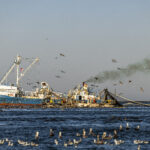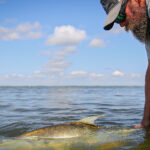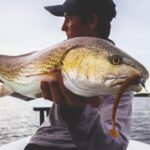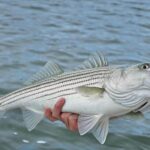
A Gulf Menhaden Deep Dive
Mario CampoFisheries Ecologist, Southeastern Louisiana UniversityScience and Policy Associate, American Saltwater Guides Association This discussion
By Willy Goldsmith Ph.D. Executive Director and Tony Friedrich VP/Policy Director
On May 7th, 2020, President Trump issued an executive order that will most certainly impact our marine fisheries. The Executive Order on Promoting American Seafood Competitiveness and Economic Growth intends to 1) combat illegal, unreported, and unregulated (IUU) fishing, 2) improve U.S. seafood access to foreign markets, 3) identify and remove unnecessary regulatory barriers restricting American commercial fishermen, and 4) expand American aquaculture in federal waters through streamlined and expedited permitting and an aggressive timetable to get projects on the water. We’re broadly supportive of the first two goals. The latter two, let’s just say, give us pause.
Addressing IUU Fishing to Support Healthy Fisheries and Honest Fishermen
ASGA strongly supports addressing IUU fishing, which robs the resource and undermines the efforts of law-abiding fishermen as well as coastal communities. The United States should never be in a position to knowingly or unknowingly support such fisheries. Section 5 of the document details the plan:
“(a) Within 90 days of the date of this order, the Secretary of Commerce, acting through the Administrator of the National Oceanic and Atmospheric Administration (NOAA), shall issue, as appropriate and consistent with applicable law, a notice of proposed rulemaking further implementing the United Nations Food and Agriculture Organization Agreement on Port State Measures to Prevent, Deter, and Eliminate Illegal, Unreported, and Unregulated Fishing, which entered into force on June 5, 2016 (the Port State Measures Agreement).” The Port State Measures Agreement, first adopted in 2009, defines actions that nations should take to detect IUU fishing for vessels seeking foreign entry into their ports.
Subsections (b) and (c) of Section 5 discuss interagency partnerships and enhancing current enforcement. Both of these items needed to be addressed. ASGA sees this as a step in the right direction for domestic fisheries. IUU fishing is a threat to us all and we’re encouraged to see these directives to constrain its incursion into American seafood markets.
Supporting Foreign Market Access for American Seafood
Section 11, like Section 5, looks to support hard-working American fishermen by establishing a multi-agency Seafood Trade Task Force:
“(c) Within 90 days of the date of this order, the Seafood Trade Task Force shall provide recommendations to the Office of the United States Trade Representative in the preparation of a comprehensive interagency seafood trade strategy that identifies opportunities to improve access to foreign markets through trade policy and negotiations, resolves technical barriers to United States seafood exports, and otherwise supports fair market access for United States seafood products.”
In complying with the tenets of the Magnuson-Stevens Act, which has rebuilt 47 stocks since 2000, American fishermen are subject to some of the strongest fisheries laws in the world. We are glad that the White House is looking to reward their efforts by helping them sell their products internationally.
Removing Barriers to Fishing—but at What Cost?
We did not have the same positive reaction with Section 4:
“Sec. 4. Removing Barriers to American Fishing. (a) The Secretary of Commerce shall request each Regional Fishery Management Council to submit, within 180 days of the date of this order, a prioritized list of recommended actions to reduce burdens on domestic fishing and to increase production within sustainable fisheries, including a proposal for initiating each recommended action within 1 year of the date of this order.”
This is perplexing. Fisheries currently operate under the Magnuson-Stevens Act (MSA) and are managed under Optimum Yield (OY) which is defined as Maximum Sustainable Yield (MSY) as reduced by any relevant social, economic, or ecological factors. In other words, OY takes into account the value of fish left in the water. So, how can you reduce burdens and increase production? Is this a directive to reallocate from the recreational sector? Does it mean that banned gear that destroys habitat or has unacceptable bycatch levels will be allowed again? Are the current monitoring and reporting systems considered burdensome by this order?
We are equally concerned about the 180-day timeline for Regional Fishery Management Councils to generate recommendations. If you know anything about fisheries management, you know that nothing happens fast. Is six months enough time for both scientists and managers to consider the potential impacts associated with easing burdens and ramping up production stocks that are already maximized?
Most of all, Section 4 ignores the value of fish left in the water. Yes, we have a seafood trade deficit, but we also have an extremely vibrant tourism economy related to recreational fishing. Less fish in the water means less demand for charters. That translates into less tackle, less hotel rooms, less visits to restaurants and so on. Maximizing production is not linear with maximizing the economy. That is why MSA uses OY. MSA includes our impact in management. Production does not.
Expanding Aquaculture: Vague Directives, Troubling Implications
The bulk of the Executive Order concerns facilitating commercial aquaculture production in federal waters, and brings with it a host of concerns. There’s a lot to unpack here, but here are our initial reactions.
Section 6, “Removing Barriers to Aquaculture Permitting,” is a great concept, and we’re supportive of assigning NOAA as the lead agency for such projects to minimize confusion, but the devil is in the details. Let us try to explain.
In the Executive Order, aquaculture is defined simply as “the propagation, rearing, and harvesting of aquatic species in controlled or selected environments.” As you can imagine, this covers an extremely wide variety of operations. Finfish, shellfish, and kelp are all defined as aquaculture. For the sake of this discussion, we can break the practice into two categories, fed vs. unfed. The unfed category includes kelp farming as well as open water shellfish aquaculture. The kelp, oysters, clams, and mussels can feed naturally without help from people, and also provide ecosystem benefits such as carbon storage, water filtration, and fish habitat. The fed category includes carnivorous finfish and often includes using wild fish as food.
While aquaculture can provide a great source of protein and remove pressure from wild stocks, there is still a deep concern over the fed category. First and foremost, we can not increase harvest of baitfish to feed large aquaculture operations. That would undermine the keystone of the ecosystem and have long lasting impacts on wild populations of fish.
ASGA is also concerned about the health of wild fish populations. Large-scale aquaculture operations can have negative impacts on wild populations from pollution, waste, and the potential for spreading of disease. All of these issues point to taking a very cautious approach to growing the fed/finfish sector of aquaculture.
All in all, the Executive Order on Promoting American Seafood Competitiveness and Economic Growth has some positives. Stopping IUU fishing is certainly a positive, as is increasing U.S. seafood industry access to foreign markets. However, it also raises come serious concerns. How can you streamline commercial fisheries production in 180 days without collateral damage? What are the details of the “fed” side of the aquaculture equation?
You can bet we will be paying close attention to the implementation of this order. We will keep you up to date and will be a voice for the resource in these discussions moving forward.

Mario CampoFisheries Ecologist, Southeastern Louisiana UniversityScience and Policy Associate, American Saltwater Guides Association This discussion

The Jack Project continues to gather momentum as tagging teams across the Gulf and South

This guide is meant to educate anglers, conservationists, and the public about the Atlantic States

Imagery Courtesy of Sean Cobelli Media We encourage anglers, guides and conservationists to use this
We rely on our members and donations to keep fighting for a sustainable tomorrow in marine conservation.
GIVE THE GIFT OF FISHERIES CONSERVATION THIS HOLIDAY SEASON. SHOP ASGA GOODS THAT FUND FISHERIES RESEARCH & ADVOCACY CAMPAIGNS
JOIN ASGA IN CALLING FOR CRITICAL MANAGEMENT ACTION AFTER YEARS OF SPAWN FAILURES & POOR MANAGEMENT.
By using this website, you agree to our use of cookies. We use cookies to provide you with a great experience and to help our website run effectively. To learn more, please review our privacy policy.
6 Responses
This EO push for marine aquaculture is all about corporate handouts to Big Ag looking for new markets for their fish kibble. Feedstock producers like Cargill, et al, are lined up at the trough.
Check the video for industrial-strength production and feed delivery here:
https://www.cargill.com/animal-nutrition/brands/ewos
On reading the ASGA’s initial reaction to the last two points of the Executive Order. Trump is making way for his cronies in the seafood industry to rape the fish stocks and the environment in and around the US waters. Which takes away from your livelihood as saltwater guides, inshore & offshore. I enjoy hooking up with a guide to do some fly fishing when it’s possible, Gulf Coast. It’s another example of the gross amount of corruption of the President and current administration.
The allegations of Corporate ‘handouts’ and ‘corruption’ have no factual evidence.
However factually, mariculture may supply for consumption or release. Once released, a specie in decline from overfishing or mortality due to freezing weather such as here with Snook, Redfish and Tarpon may be sustained. A win for the repopulation, habitat and fishery. That’s a fact.
We have a State chartered mariculture center that has repopulated redfish and inshore cobia. It receives State and private funding.
Good for you Capt. Allen Jackson on posting a truthful comment using facts instead of non-factual feelings. Promoting any industry has it’s good points and it’s shortfalls. There are always going to be winners and losers. Threading the fine line between the two is where the future lies for our industry.